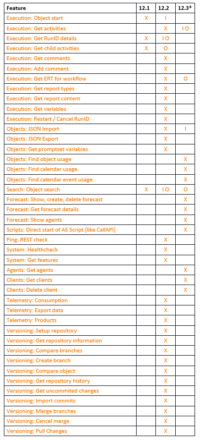A guest post by Joel Wiesmann.
With version 12.1, the Automation Engine got a new method to connect with third-party applications: a REST Interface.
REST (short for representational state transfer) is a set of guidelines on how to create an interface to an application. Interfaces based on these guidelines are called “REST Interfaces”. Tools like Twitter, JIRA, and ServiceNow already use this since some time.
A modern application is web-based and has a REST interface for third-party integration. The nice thing is, once you’ve worked with REST, it’s easy to interact with REST interfaces from other applications.
Functionality of the Automic REST Interface
The transition from “UC4.JAR”, which communicates with Automic in the classical way, to a web-based REST interface is complex and extensive. Therefore Automic extends the capabilities of the REST interface bit by bit. New features will probably not be supported in the Java ApplicationInterface API in the future. The following table shows the progress of the REST interface (click to enlarge the table):
How to connect to the Automic REST Interface?
The Java API has implemented an Automic-specific protocol. The Automic REST Interface, on the other hand, consists of plain text messages in JSON format, which are transmitted via HTTP(S).
You can simulate a read operation with a simple browser by accessing a URL. Ask your admin where he set up the REST Endpoint for the AWI.
If you have a user and no firewall is interfering, you can use the following URL to display the current activities:
https://<rest endpoint>:<port>/ae/v1//executions
For example:
https://myRestInterface.internal.ch:8088/ae/v1/1234/executions
You’ll receive an anser in JSON format, a data format from the Javascript world. It is easy to read and interpret for machines, but has significantly less ballast, which makes it easier to read for humans.
How to Work with the Interface
The REST interface is very easy to address. You can implement code in either a programming language such as Java or C #, or access the interface in simple scripting languages such as Unix shell scripts (using curl), Python, Powershell, or via Web / Javascript. Of course, it’s also possible with Automic’s REST Webservice Object.
Would you like to know more about the Automic REST interface and its purpose? Please write me in the comments what you’re interested in.
 Joel Wiesmann
Joel Wiesmann
Automic Experte
Joel Wiesmann ist diplomierter Informatik Techniker aus der Schweiz und arbeitet seit vielen Jahren mit der Automation Engine.
Er hat den WorkflowCommander erstellt und bietet ihn hier auf der Seite gemeinsam mit einem E-Learning an.

